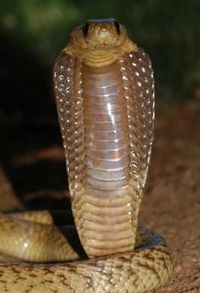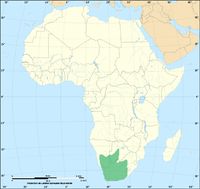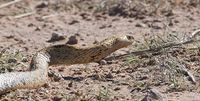Cape cobra
| Cape cobra | ||||||||||||||||||||
|---|---|---|---|---|---|---|---|---|---|---|---|---|---|---|---|---|---|---|---|---|
 Cape cobra
| ||||||||||||||||||||
| Scientific classification | ||||||||||||||||||||
| ||||||||||||||||||||
| Binomial name | ||||||||||||||||||||
| Naja nivea (Linnaeus, 1758)[1][2] | ||||||||||||||||||||
 Distribution of the Cape cobra
| ||||||||||||||||||||
| Synonyms | ||||||||||||||||||||
|
The Cape cobra (Naja nivea), also called the yellow cobra is a medium sized, highly venomous cobra inhabiting a wide variety of biomes across southern Africa including arid savanna, fynbos, bushveld, desert and semi-desert regions. The species is diurnal and is a feeding generalist, preying on a number of different species and carrion. Predators of this species include birds of prey and different species of mongoose. The Cape cobra is also known as the "geelslang" (yellow snake) and "bruinkapel" (brown cobra) in South Africa. Afrikaans speaking South Africans also refer to the Cape cobra as "koperkapel", mainly because of a rich yellow color variation. This species has no known subspecies.
Etymology
The Cape cobra was first described by Swedish zoologist Carl Linnaeus in 1758.[1] The generic name naja is a Latinisation of the Sanskrit word nāgá (नाग) meaning "cobra". The specific epithet nivea is derived from the Latin words either nix or nivis meaning "snow" or niveus meaning "snowy".[3]
Description
The Cape cobra is a medium sized species of cobra. Specimens typically average around 1.2 to 1.4 m (3.9 to 3.6 ft) long, but it may grow up to 1.6 m (5.25 ft) in length. Males are slightly larger than females. The longest specimen on record was a male from Aus, Namibia and measured 1.87 m (6.14 ft) long.[4] Another very large specimen was also a male found in De Hoop Nature Reserve with a total length of 1.85 m (6.07 ft).[5] This species shows a wide range of colour variation; from yellow and golden brown to dark brown and even black. In addition, individuals show a varying degree of black or pale stippling and blotches, and although it has been stated that colour and marking are geographically related, it is also possible to observe virtually all colour varieties at one location. For example, it is well known that the Kalahari Desert specimens in Botswana and Namibia are usually more consistently yellow than the more southerly populations.[6] However, at DeHoop, and other specific locations in the Western Cape, all colour variations have been recorded.[5]
Scalation
Midbody scales are in 19-21 rows, with 195-227 ventrals and 50-68 paired subcaudals. The anal shield is entire. There are 7 upper labials with the 3rd and 4th entering the eye, and 9 (sometimes 8 or 10) lower labials, as well as 1 preocular and 3 (sometimes 4) postoculars. Temporals are variable, usually 1+3.
Distribution and habitat
Geographical distribution
This species is endemic to southern Africa. In South Africa, where it mainly occurs, they can be found throughout the Cape Province, Free State Province, and southwestern Transvaal. It is also found in the southern half of Namibia, southwestern Botswana, and western Lesotho. They are also found in the Kalahari desert, particularly in the southern regions of the Kalahari.[5][6]
Habitat
Although the Cape cobra has the smallest geographical range of any other African cobra, it occurs in a variety of different habitats. This species' preferred habitat is fynbos, bushveld, karoo scrubland, arid savanna, and deserts such as the Namib desert and the Kalahari desert where it can be found in rodent burrows, abandoned termite mounds and, in arid regions, rock crevices. Where it occurs in temperate regions and arid karroid regions, it is often found along rivers and streams entering well-drained, open areas. In Lesotho, they can even be found in altitudes as high as 2500 m (8202.1 ft) above sea level. They occur in forest and high grassland areas of Free State province. It can also be found in rocky hills of the Cape and in desert and semi-desert areas of its geographical range. Cape cobras are also known to venture into villages, partially developed suburbs, and squatter communities where they may enter houses to escape the heat of the day. This brings them into direct contact with humans.[4][6]
Behaviour and ecology
Behaviour
The Cape cobra is a diurnal species and actively forages throughout the day. During very hot weather it may become crepuscular, but is rarely if ever observed during the hours of darkness.[5] It is a terrestrial snake, but will readily climb trees and bushes. When not active, it hides in holes or under ground cover, such as brush piles, often remaining in the same retreat for some time. It is a quick moving and alert species,[6] and although generally not as aggressive as some other African species of venomous snake,[5] when disturbed the Cape cobra will raise its forebody off the ground and spread a broad hood and hiss loudly. Once on the defensive, it strikes readily.[6] If the threat remains motionless, the snake will quickly look for an escape, but any sort of movement will get the snake into a defensive posture again.[4] The Cape cobra is more aggressive during the mating period.[6]
Diet
This species of cobra is a feeding generalist.[5] It feeds on a wide spectrum of prey, including other snakes, rodents, lizards, birds, and carrion. Recorded prey items for this species at DeHoop from October 2004 to March 2006 showed that 31% of the species' diet consisted of rodents, 20% was other snakes (including juvenile and small adult puff adders), 11% lizards, 11% birds, 16% carrion, and 11% "conspecifics". In the same study period conducted at DeHoop, Cape cobras were seen scavenging and feeding on carrion on two occasions.[7] Both were road-killed snakes, the first, an adult Psammophylax rhombeatus, the second an adult Karoo whip snake, Psammophis notostictus. It is also well known for raiding Sociable Weaver (Philetairus socius) nests.[4] Cape cobras can be cannibalistic, sometimes eating the young of its own kind.[6]
Predators
Predators of the Cape cobra include the honey badger (Ratel),[8] other carnivorous mammals, various birds of prey (secretary birds and snake eagles), and other snakes may also prey on this species.[4] Meerkats and the mongoose, which have a high resistance to its venom, often prey on the Cape cobra and are its main predators.[6]
Reproduction
This species is oviparous. Mating season is during the months of September and October, when these snakes may be more aggressive than usual. Females will lay between 8 and 20 eggs (roughly 60 X 25 mm in size) in midsummer (December–January), in a hole or an abandoned termite mound or some other warm, wet location.[6] The hatchlings measure between 34 and 40 cm (13 and 16 in) in length[4] and are completely independent from birth. In one captive study, mating occurred in the month of September and oviposition in November. Gestation period was approximately 42 days and the incubation period was 65–70 days at about 28-33°C (82.4-91.4°F). Clutch size was 11-14 (n=2) and hatchling ratio was one male to five females.[9]
Venom
The Cape cobra is regarded as one of the most dangerous species of cobra in all of Africa, by virtue of its potent venom and frequent occurrence around houses.[10] The venom of this snake tends to be thick and syrupy in consistency and dries into shiny pale flakes, not unlike yellow sugar. It is highly toxic and may be more potent than that of any other African cobra.[6] The Cape cobras venom is made up of potent postsynaptic neurotoxins and might also contain cardiotoxins,[11] that affect the respiratory system, nervous system, and the heart. The murine subcutaneous LD50 for this species' venom is 0.7 mg/kg, while the intravenous and intraperitoneal LD50 values are 0.4 mg/kg and 0.6 mg/kg, respectively.[12] The average venom yield per bite is 100 to 150 mg according to Minton. The mortality rate for untreated bites is not exactly known, but is thought to be high; however, a bite is not always fatal, even if it goes untreated. This can be due to various factors including the amount of venom injected, psychological state of the bitten subject, the penetration of one or both fangs, and so on. Mechanical ventilation and symptom management is often enough to save a victim's life, but cases of serious Cape cobra envenomation will require antivenom. When death does occur, it normally takes anywhere from an hour (in severe cases) to ten hours (or more) and it is often as a result of respiratory failure, due to the onset of paralysis.[11] The antivenom used in case of a bite is a polyvalent antivenom produced by the South African Institute of Medical Research (SAIMR).[13]
Cited references
- ↑ 1.0 1.1 Naja nivea (TSN 700634) at Integrated Taxonomic Information System. Accessed 9 May 2012.
- ↑ Naja nivea (Linnaeus, 1758) at The Reptile Database. Accessed 9 May 2012.
- ↑ Etymology of Nivis. Etymology. Etymology Online. Retrieved on 9 May 2012.
- ↑ 4.0 4.1 4.2 4.3 4.4 4.5 Marais, Johan (2004). A Complete Guide to the Snakes of Southern Africa. Cape Town, South Africa: Struik Nature, 100–101. ISBN 186872932X.
- ↑ 5.0 5.1 5.2 5.3 5.4 5.5 Phelps, T. Observations of the Cape cobra, Naja nivea (Serpentes: Elapidae) in the DeHoop Nature Reserve, Western Cape Province, South Africa. Herpetological Bulletin. Cape Reptile Institute. Retrieved on 9 May 2012.
- ↑ 6.0 6.1 6.2 6.3 6.4 6.5 6.6 6.7 6.8 6.9 Spawls, Stephen (1995). Dangerous Snakes of Africa. London, UK: Blandford Press, 81–82. ISBN 0713723947.
- ↑ Phelps, T.. Elapidae (Naja nivea) Scavenging. African Herp News (40) June 2006. Cape Reptile Institute. Retrieved on 9 May 2012.
- ↑ Begg, Colleen and Keith. "Honey Badgers Diet." Honey badger research project by the Beggs. Honey Badgers. Accessed 9 May 2012.
- ↑ Morgan, Haagner, Dave, Gerald. Husbandry and Propagation of the Cape cobra (Naja nivea) at the Manyeleti Reptile Centre (pg 3). The Journal of Herpetological Association of Africa. Retrieved on 9 May 2012.
- ↑ Morgan, Haagner, Dave, Gerald. Husbandry and Propagation of the Cape cobra (Naja nivea) at the Manyeleti Reptile Centre (pg 1). The Journal of Herpetological Association of Africa. Retrieved on 9 May 2012.
- ↑ 11.0 11.1 Naja nivea: General Details. Clinical Toxinology Resource. University of Adelaide. Retrieved on 9 May 2012.
- ↑ Brown, John H. (1973). Toxicology and Pharmacology of Venoms from Poisonous Snakes. Springfield, IL USA: Charles C. Thomas, 81. ISBN 0-398-02808-7.
- ↑ Davidson, Terence. IMMEDIATE FIRST AID For bites by Cape Cobra (Naja nivea). Snakebite Protocol. University of California, San Diego. Retrieved on 9 May 2012.
